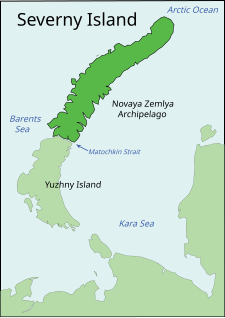Uninhabited island in Russian Arctic
Severny Island (Russian: Се́верный о́стров, romanized: Severnyy ostrov, lit. 'Northern Island') is a Russian Arctic island. It is the northern island of the Novaya Zemlya archipelago.
It was historically called Lütke Land after Friedrich Benjamin von Lütke, who explored it. It lies approximately 400 km north of the Russian mainland. It has an area of 48,904 square kilometres (18,882 sq mi), making it the 30th-largest island in the world[1] and the 3rd-largest uninhabited island in the world. It is part of Russian Arctic National Park.[2]
Geography
Severny Island is separated from Yuzhny Island (Southern) by the narrow Matochkin Strait. Forty percent of the island is covered by the Severny Island ice cap, which is the largest glacier by area and by volume in Europe (if counted as part of it).[3] Severny Island is known for its numerous glaciers.[4] Cape Flissingsky is the easternmost point of Severny Island.
Climate
Severny Island has a cold tundra climate (Köppen climate classification ET), with average temperatures barely reaching the freezing mark in the warmest months. The temperature varies from −5 to −37 °C (23 to −35 °F) in winter to −9 to 5 °C (16 to 41 °F) in summer.
| Climate data for Severny Island
|
| Month
|
Jan
|
Feb
|
Mar
|
Apr
|
May
|
Jun
|
Jul
|
Aug
|
Sep
|
Oct
|
Nov
|
Dec
|
Year
|
| Mean maximum °C (°F)
|
−7
(19)
|
−7
(19)
|
−6
(21)
|
−4
(25)
|
−1
(30)
|
3
(37)
|
5
(41)
|
4
(39)
|
1
(34)
|
−1
(30)
|
−4
(25)
|
−5
(23)
|
5
(41)
|
| Mean daily maximum °C (°F)
|
−19
(−2)
|
−18
(0)
|
−15
(5)
|
−12
(10)
|
−6
(21)
|
−2
(28)
|
0
(32)
|
−1
(30)
|
−3
(27)
|
−8
(18)
|
−13
(9)
|
−17
(1)
|
−9
(15)
|
| Mean daily minimum °C (°F)
|
−26
(−15)
|
−25
(−13)
|
−23
(−9)
|
−19
(−2)
|
−10
(14)
|
−5
(23)
|
−2
(28)
|
−4
(25)
|
−6
(21)
|
−13
(9)
|
−20
(−4)
|
−24
(−11)
|
−15
(6)
|
| Mean minimum °C (°F)
|
−37
(−35)
|
−36
(−33)
|
−34
(−29)
|
−29
(−20)
|
−18
(0)
|
−9
(16)
|
−6
(21)
|
−8
(18)
|
−12
(10)
|
−22
(−8)
|
−30
(−22)
|
−35
(−31)
|
−37
(−35)
|
| Average precipitation mm (inches)
|
24
(0.9)
|
28
(1.1)
|
31
(1.2)
|
33
(1.3)
|
33
(1.3)
|
38
(1.5)
|
44
(1.7)
|
47
(1.9)
|
62
(2.4)
|
64
(2.5)
|
42
(1.7)
|
32
(1.3)
|
478
(18.8)
|
| Average precipitation days (≥ 0.1 mm)
|
11.1
|
11.1
|
13.4
|
14.7
|
14.8
|
13.8
|
12.9
|
14.2
|
18.8
|
20.1
|
15.6
|
14.3
|
174.8
|
| Average snowy days
|
11.1
|
11.1
|
13.4
|
14.6
|
14.7
|
12.1
|
7.5
|
8.6
|
15.9
|
19.8
|
15.5
|
14.3
|
158.6
|
| Source: Meteoblue[5]
|
Ice cap and glaciers
Unlike Yuzhny Island, Severny has an inner ice cap with numerous glaciers, most of which have their terminus on the eastern or western shore of the island.[6]
History
The cape of Sukhoy Nos, located at the southern end of the island, was used for nuclear weapons testing between 1958 and 1961. The Tsar Bomba hydrogen bomb test on October 30, 1961 destroyed all buildings in the village of Severny (both wooden and brick).[7] The village was located 55 kilometres (34 miles) from ground zero within the Sukhoy Nos test range. Tsar Bomba was the most powerful nuclear weapon detonated and was the most powerful anthropogenic explosion in human history. It had a yield of 50 megatons of TNT, scaled down from its maximum 100 megaton design yield.[8] Severny is now the site of a Russian Army base and has a harbor.
There is a meteorological station at Cape Zhelaniya, Severny's northernmost cape.[9]




